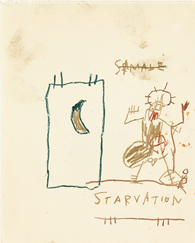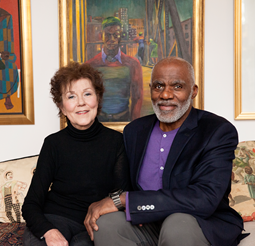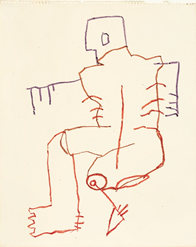Phillips to Sell Works by Jean-Michel Basquiat from the
Diane and Alan Page Collection
Former State Supreme Court Justice, NFL Hall of Famer, Education Reformer, Presidential Medal of Freedom Recipient, Children’s Book Author, and Philanthropist to Offer Two Fresh-to-Market Works
|
Jean-Michel Basquiat Untitled (Starvation), 1981 Estimate: $250,000 - 350,000 |
Diane and Alan Page Credit: Katie Cannon |
Jean-Michel Basquiat Untitled (The Athlete), 1981 Estimate: $200,000 - 300,000 |
NEW YORK – 5 MAY 2021 – Phillips is pleased to announce the sale of two works from the collection of former Minnesota State Supreme Court Justice and Legendary NFL Hall of Famer Alan Page. Held in the acclaimed collection of Justice Alan and Diane Page for over 35 years, Untitled (Starvation) and Untitled (The Athlete) are milestones of the revolutionary approach that launched Jean-Michel Basquiat to international acclaim in 1981. Their inclusion in Phillips’ 20th Century & Contemporary Art Day Sale on 24 June marks the first time that they have ever been offered publicly.
Of the works, which were authenticated by the artist’s father Gerard Basquiat, Justice Page said, “Initially, when Diane and I started collecting art in the 1970s it was about collecting beautiful objects, but over time, our focus shifted to objects that talk about who we are as a people; where we have been, where we are now, and where we should be going. Today’s collection shines a light on the beauty of African American art and culture, while also shining a light on the horrors of slavery and the Jim Crow era. While it has been our good fortune to be the caretakers of Starvation and The Athlete for so many years - and they will be missed - we’ve had almost thirty years of enjoyment from them and it’s time for someone else to have that opportunity.”
John McCord, Phillips’ Co-Head of Day Sale, said, “In their forty-five years together, Diane and Alan Page formed one of the most remarkable collections of contemporary art and African Americana in private hands, all while continuing to serve their community in Minneapolis in countless and unprecedented ways. Given their keen eye for artists who helped to define 20th century culture and bring discussions of racial equity to the fore, it comes as no surprise that Starvation and The Athlete were such treasured pieces in their collection for over three decades.”
Four years after executing Starvation and The Athlete, Basquiat emerged from New York’s underground art scene and exploded onto the cover of The New York Times Magazine. As the first artist of color to be compared to the likes of Picasso and Francis Bacon, the Times feature marked a seismic shift in a culture rife with racism. Basquiat’s impact reverberated beyond the confines of the New York art scene, reaching people across the country and around the world – including Alan Page’s daughter Georgi, 1,000 miles away in Minneapolis. The artist’s work made such a deep impression on the 15-year-old that her father and stepmother — who already owned works by contemporary artists like Andy Warhol, Jim Dine and Helen Frankenthaler — were convinced to seek out Basquiat’s work on their next trip to New York.
Untitled (Starvation) and Untitled (The Athlete) are two exemplary works depicting subjects that would become central to the vernacular of Basquiat’s brief output: an anthropomorphic god figure with the artist’s famous crown-of-thorns motif, and a monumental—yet fallible—athlete. Basquiat’s unbridled genius shines in these pieces, executed when he was on the cusp of unprecedented critical and commercial success.
The formidable figure in Starvation shows his strength as he raises his arms in victory, warning, or supplication. The crossed-out text “Samale”— possibly an invocation of the fierce monkey-man god of African mythology—is juxtaposed here with a crown of thorns, a frequent element in Basquiat’s iconography. Just as Basquiat eventually took his own place in the pantheon of cultural icons, the gladiator in The Athlete shows a deep affinity with athletes that the artist celebrated, including Muhammad Ali, Joe Louis, and Hank Aaron. The work is a vivid example of Basquiat’s understanding of the athlete as an epic figure fighting for the respect and recognition whose corollary is perpetual vulnerability: to racism, to objectification, and to deeply entrenched stereotypes of masculinity.
While western art history has valorized Judeo-Christian gods and saints, Basquiat sought to exalt idols of Black history and animist religions. In particular, the artist admired how these athletes and gods fearlessly challenged pervasive social and racial boundaries: many had, literally and figuratively, fought their way not just to success but to physical and spiritual freedom.
ABOUT DIANE AND ALAN PAGE
When Alan and Diane Page met in the early 1970s, Alan was already one of the most accomplished defensive players in the National Football League (NFL), but by the end of the decade, he had become a legendary athlete playing with the Minnesota Vikings. It was partly Page’s experience fighting for his rights as a player representative during the NFLPA strike in the 1970s that inspired him to go to law school and earn his Juris Doctor in 1978.
Following Page's retirement from professional football, he served as an assistant attorney general, eventually suing for the right to run for the Minnesota Supreme Court. When he won that race in 1992, he became the state’s first African American associate justice. In the intervening years, he and Diane launched the Page Education Foundation and, since Diane’s passing in 2018, Alan and his family have remained passionately devoted to social causes. Page accepted the Medal of Freedom in 2018 and, in 2020, helped launch a campaign to amend the Minnesota constitution with a proposed ‘Page Amendment’ to make a quality public school education a basic right for all children. As a testament to his unending dedication to his community, The Justice Alan Page Elementary School is currently being built and is the second school to be named for Justice Page. The first was re-named in an initiative led by student activists.
Throughout her life Diane Page shared her husband’s unwavering commitment to social justice and activism, breaking many of her own barriers and also serving as Executive Director of the Page Education Foundation. Moreover, she was the driving force behind the family’s unique collection of African American artifacts, painstakingly curated to teach its viewers about the perils of racism and presented in the record-breaking TESTIFY exhibit which coincided with Super Bowl LII. The collection, helmed by Georgi Page, both reflects and inspires the Page Family's social justice work, and today constitutes one of the most unique and comprehensive personal collections of African Americana in the United States.
Auction: 24 June 2021
Click here for more information: https://www.phillips.com/auctions/auction/NY010421


